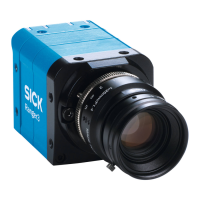Note that when the camera acquires 2D images, a frame is the same thing as a
complete 2D image. When the camera acquires 3D images, each frame is a set of
profiles. This means that the acquisition of profiles and the Line triggering concept are
only applicable for 3D images, while the 2D image triggering concept is only relevant for
2D images.
Frame triggering The camera will acquire frames based on an external input signal,
for example from a photoelectric sensor.
The acquisition of profiles can either be free-running or triggered
by an input signal, as described in the sections Free-running and
Line triggering below.
Line triggering The camera will acquire each profile based on an external input
signal. There are two possibilities:
•
Connect an external input signal to the line trigger input of the
device.
•
Use an encoder for line triggering. In that case, pulses are
received on the encoder inputs. The distance between two
profiles is determined by the number of pulses received.
Triggering each profile from an encoder will keep the object pro‐
portions if the object motion, tracked by the encoder, changes.
Four-phase encoders also allow tracking different motion pat‐
terns, see "Triggering using an encoder", page 46. The motion
pattern is defined by the EncoderOutputMode parameter.
When you use the line trigger input, each pulse on the line trig‐
ger input triggers one profile. Profiles are triggered when the
object is moving either backward or forward. The EncoderOutput‐
Mode parameter is not used.
Free-running The camera will acquire 2D images (in Areascan mode) or profiles
(in Linescan3D mode) with a regular time interval. In Areascan
mode the time interval is controlled by the AcquisitionFrameRate
parameter and in Linescan3D mode by the AcquisitionLineRate
parameter.
When the acquisition of profiles is free-running, the distance
between two profiles varies if the speed of the object is not
constant. This may distort the image. To avoid distortion, you can
use an encoder and record the counter value for each profile.
This information makes it possible to calculate a correct image.
2D image triggering The camera will acquire 2D images based on external pulses on
the encoder inputs.
The use of a four-phase encoder allows tracking of different
motion patterns. The principles for motion tracking during 2D
image triggering are the same as for line triggering, see "Trigger‐
ing using an encoder", page 46.
8.10.3 Triggering using an encoder
When you use an encoder for triggering, the camera counts the number of pulses
received on the encoder inputs using an internal counter. When the specified number
of pulses has been received, a profile or a 2D image is triggered and the camera resets
the triggering condition counter.
8 CONFIGURATION
46
O P E R A T I N G I N S T R U C T I O N S | Ranger3 8020774/1D7Q/2022-03 | SICK
Subject to change without notice

